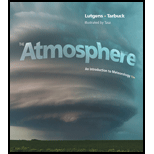
The Atmosphere: An Introduction to Meteorology (13th Edition) (MasteringMeteorology Series)
13th Edition
ISBN: 9780321984623
Author: Frederick K. Lutgens, Edward J. Tarbuck, Dennis G. Tasa
Publisher: PEARSON
expand_more
expand_more
format_list_bulleted
Question
Chapter 4.4, Problem 2CC
(a)
To determine
The time in which relative humidity is the highest and lowest during a typical day.
(b)
To determine
The time of day in which dew is most likely to form.
(c)
To determine
A generalization that relates changes in air temperature to changes in relative humidity.
Expert Solution & Answer
Want to see the full answer?
Check out a sample textbook solution
Students have asked these similar questions
Seee the attached ima
You were hired as a HACCP specialist to set up a HACCP plan in a small meat ball shop which produces different kinds of meat balls. The major and common ingredients used for different meat ball recipes includes: flour, frozen pork mince, salt, sugar, pepper, oil, etc. And the major unit operations involve defrosting, mixing, extrusion + cutting, deep-frying, cooling and vacuum packaging.In the space provided, answer the following questions:a. List the steps in sequence involve in setting up the HACCP plan.b. Elaborate in detail any 5 steps in question (a). c. Provide examples related to the each of the steps you elaborate in question (b) and related to the meat ball production. d. If there are complaints from the consumers about the quality of one type of meat balls, describe how will you utilize one or more problem-solving tools in sequence to solve the quality problem.Include the purpose(s) for using the tools. List any assumptions you made, if any.
Please see the attached image.
Chapter 4 Solutions
The Atmosphere: An Introduction to Meteorology (13th Edition) (MasteringMeteorology Series)
Ch. 4.1 - Prob. 1CCCh. 4.1 - Prob. 2CCCh. 4.1 - Prob. 3CCCh. 4.1 - Prob. 4CCCh. 4.1 - Prob. 5CCCh. 4.2 - Prob. 1CCCh. 4.2 - Prob. 2CCCh. 4.2 - Prob. 3CCCh. 4.2 - Prob. 4CCCh. 4.3 - Prob. 1CC
Ch. 4.3 - Prob. 2CCCh. 4.3 - Prob. 3CCCh. 4.4 - Prob. 1CCCh. 4.4 - Prob. 2CCCh. 4.4 - Prob. 3CCCh. 4.4 - Prob. 4CCCh. 4.4 - Prob. 5CCCh. 4.4 - Prob. 6CCCh. 4.5 - Prob. 1CCCh. 4.5 - Prob. 2CCCh. 4.5 - Prob. 3CCCh. 4.5 - Prob. 4CCCh. 4.5 - Prob. 5CCCh. 4.6 - Prob. 1CCCh. 4.6 - Prob. 2CCCh. 4.6 - Prob. 3CCCh. 4.6 - Prob. 4CCCh. 4.6 - Prob. 5CCCh. 4.7 - Prob. 1CCCh. 4.7 - Prob. 2CCCh. 4.7 - Prob. 3CCCh. 4.7 - Prob. 4CCCh. 4.7 - Prob. 5CCCh. 4.8 - Prob. 1CCCh. 4.8 - Prob. 2CCCh. 4.8 - Prob. 3CCCh. 4.8 - Prob. 4CCCh. 4 - Prob. 1GSTCh. 4 - Prob. 10GSTCh. 4 - Prob. 2GSTCh. 4 - Prob. 3GSTCh. 4 - Prob. 4GSTCh. 4 - Prob. 5GSTCh. 4 - Prob. 6GSTCh. 4 - Prob. 8GSTCh. 4 - Prob. 7GSTCh. 4 - Prob. 9GSTCh. 4 - Prob. 1PCh. 4 - Prob. 4PCh. 4 - Prob. 5P
Knowledge Booster
Similar questions
- Please answer with math that is legible.arrow_forwardComplete the mechanismarrow_forwardV Biological Macromolecules Drawing the Haworth projection of an aldose from its Fischer projection Draw a Haworth projection of a common cyclic form of this monosaccharide: H C=O HO H HO H H OH CH₂OH Explanation Check Click and drag to start drawing a structure. Xarrow_forward
- Complete the mechanismarrow_forwardComplete the mechanismarrow_forward1. Consider fully developed, steady, laminar blood flow in the annulus between a blood vessel and a catheter, as shown in Figure 1. Flow is in the x direction (note the axes shown). The vessel walls are stationary, but the catheter moves in the x direction with speed U. The radius of the catheter is Rc and the radius of the blood vessel is equal to KR, where k = 2. Assume the axial pressure gradient for flow in the annulus is op/ox = -5 mmHg/cm. RC r U X kRc Figure 1. Catheter (in gray) inserted in a blood vessel. a.) Write an appropriate equation for the motion inside the annulus. (For the purposes of this problem, you may assume that the blood behaves as a Newtonian fluid). In order to get full credit, justify all the assumptions you make to simplify the equation.arrow_forward
arrow_back_ios
SEE MORE QUESTIONS
arrow_forward_ios